| dc.date.accessioned | 2023-06-16T08:51:36Z | |
| dc.date.available | 2023-06-16T08:51:36Z | |
| dc.date.issued | 2023-06-07 | |
| dc.identifier | doi:10.17170/kobra-202306168244 | |
| dc.identifier.uri | http://hdl.handle.net/123456789/14834 | |
| dc.description.sponsorship | Gefördert durch den Publikationsfonds der Universität Kassel | |
| dc.language.iso | eng | |
| dc.rights | Namensnennung 4.0 International | * |
| dc.rights.uri | http://creativecommons.org/licenses/by/4.0/ | * |
| dc.subject | fiber reinforced composites | eng |
| dc.subject | bio-polyamide | eng |
| dc.subject | glass fiber | eng |
| dc.subject | cellulosic fiber | eng |
| dc.subject | VOC analysis | eng |
| dc.subject | emission | eng |
| dc.subject | sensory evaluation | eng |
| dc.subject | odor | eng |
| dc.subject | mechanical properties | eng |
| dc.subject.ddc | 540 | ger |
| dc.subject.ddc | 600 | ger |
| dc.title | Emission and Mechanical Properties of Glass and Cellulose Fiber Reinforced Bio-Polyamide Composites | eng |
| dc.type | Aufsatz | |
| dcterms.abstract | Climate change, access, and monopolies to raw material sources as well as politically motivated trade barriers are among the factors responsible for a shortage of raw materials. In the plastics industry, resource conservation can be achieved by substituting commercially available petrochemical-based plastics with components made from renewable raw materials. Innovation potentials are often not used due to a lack of information on the use of bio-based materials, efficient processing methods, and product technologies or because the costs for new developments are too high. In this context, the use of renewable resources such as fiber-reinforced polymeric composites based on plants has become an important criterion for the development and production of components and products in all industrial sectors. Bio-based engineering thermoplastics with cellulose fibers can be used as substitutes because of their higher strength and heat resistance, but the processing of this composite is still challenging. In this study, composites were prepared and investigated using bio-based polyamide (PA) as a polymer matrix in combination with a cellulosic fiber and, for comparison purposes, a glass fiber. A co-rotating twin-screw extruder was used to produce the composites with different fiber contents. For the mechanical properties, tensile tests and charpy impact tests were performed. Compared to glass fiber, reinforced PA 6.10 and PA 10.10, a significantly higher elongation at break with regenerated cellulose fibers, can be achieved. PA 6.10 and PA 10.10 achieve significantly higher impact strengths with the regenerated cellulose fibers than the composites with glass fibers. In the future, bio-based products will also be used in indoor applications. For characterization, the VOC emission GC-MS analysis and odor evaluation methods were used. The VOC emissions (quantitative) were at a low level but the results of the odor tests of selected samples showed values mostly above the required limit values. | eng |
| dcterms.accessRights | open access | |
| dcterms.creator | Wolff, Susanne | |
| dcterms.creator | Rüppel, Annette | |
| dcterms.creator | Rida, Hassan Ali | |
| dcterms.creator | Heim, Hans-Peter | |
| dc.relation.doi | doi:10.3390/polym15122603 | |
| dc.subject.swd | Mechanische Eigenschaft | ger |
| dc.subject.swd | Cellulosefaser | ger |
| dc.subject.swd | Glasfaser | ger |
| dc.subject.swd | Polyamide | ger |
| dc.subject.swd | Emission | ger |
| dc.type.version | publishedVersion | |
| dcterms.source.identifier | eissn:2073-4360 | |
| dcterms.source.issue | Issue 12 | |
| dcterms.source.journal | Polymers | |
| dcterms.source.volume | Volume 15 | |
| kup.iskup | false | |
| dcterms.source.articlenumber | 2603 | |


